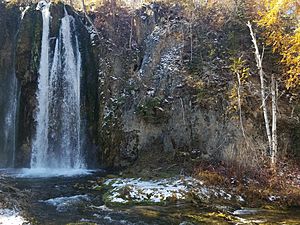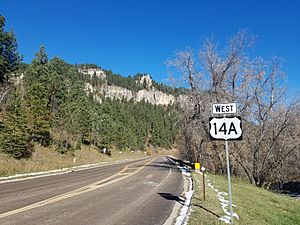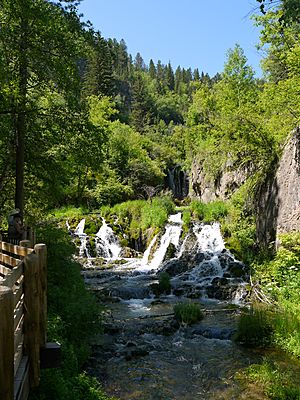Spearfish Canyon facts for kids
Spearfish Canyon is a beautiful, deep, and narrow valley in South Dakota. It was carved by Spearfish Creek. You can find it just south of the town of Spearfish, inside the amazing Black Hills. It's also right on the edge of the Black Hills National Forest.
A special road called the Spearfish Canyon Scenic Byway goes through the canyon. This road, U.S. Route 14A, travels from Spearfish to Cheyenne Crossing. It follows an old railroad path. This railroad was left behind after a huge flood in 1933.
Contents
How Spearfish Canyon Formed
About 600 million years ago, this area was covered by a vast sea. Imagine the whole place underwater! Over millions of years, the water slowly went away. Land began to appear between 60 and 30 million years ago.
As the land rose, rivers and streams started to flow. These waterways, like Spearfish Creek, slowly wore away the softer rocks. This process created deep valleys, or canyons, like Spearfish Canyon. Today, the scenic highway winds right through this ancient landscape.
This area is a special meeting point for different kinds of plants and trees. You can find plants from the Rocky Mountains, eastern forests, northern woodlands, and even the Great Plains all in one place here.
Plants and Animals of the Canyon
Spearfish Canyon is home to many different kinds of plants and animals. South Dakota has about 1,585 plant types. A large number of these, about 1,260 species, grow in the Black Hills. Many of them thrive right here in Spearfish Canyon.
Trees and Plants
The most common trees in the Black Hills are Ponderosa pines. These tall, strong trees are a big part of the canyon's green landscape.
Birds and Wildlife
Many different birds fly through the canyon. You might spot turkeys walking on the ground or bluejays in the trees. Woodpeckers tap on trunks, and cliff swallows build nests on the canyon walls. Small chickadees flit among the branches. If you are lucky, you might even see a golden eagle or a bald eagle soaring high above.
The canyon also supports many four-legged animals. White-tail deer and mule deer are often seen along the roads. You might also spot porcupines, raccoons, squirrels, and chipmunks. Sometimes, a bobcat or a yellow-bellied marmot might make an appearance.
Rock Layers of Spearfish Canyon
Geologists, who study rocks and the Earth, often visit Spearfish Canyon. They are interested in the very old rocks found here. These rocks, called Precambrian rocks, are exposed by the creek bed.
The tall walls of the canyon are made of three main types of rock. Each layer looks different and tells a story about Earth's past.
- Deadwood Shale: This is the bottom layer of rock. It is brown and looks like it has many layers stacked together. It can be from 10 to 400 feet thick. This rock sits on top of even older Precambrian rock.
- Englewood Limestone: In the middle, you will find this rock layer. It is pink to red in color. This layer is usually about 30 to 60 feet thick.
- Paha Sapa Limestone: This is the top layer and the thickest one. It is between 300 and 600 feet thick. It looks buff-colored but often appears gray because of weathering. Caves and fossils are often found in this type of limestone.




